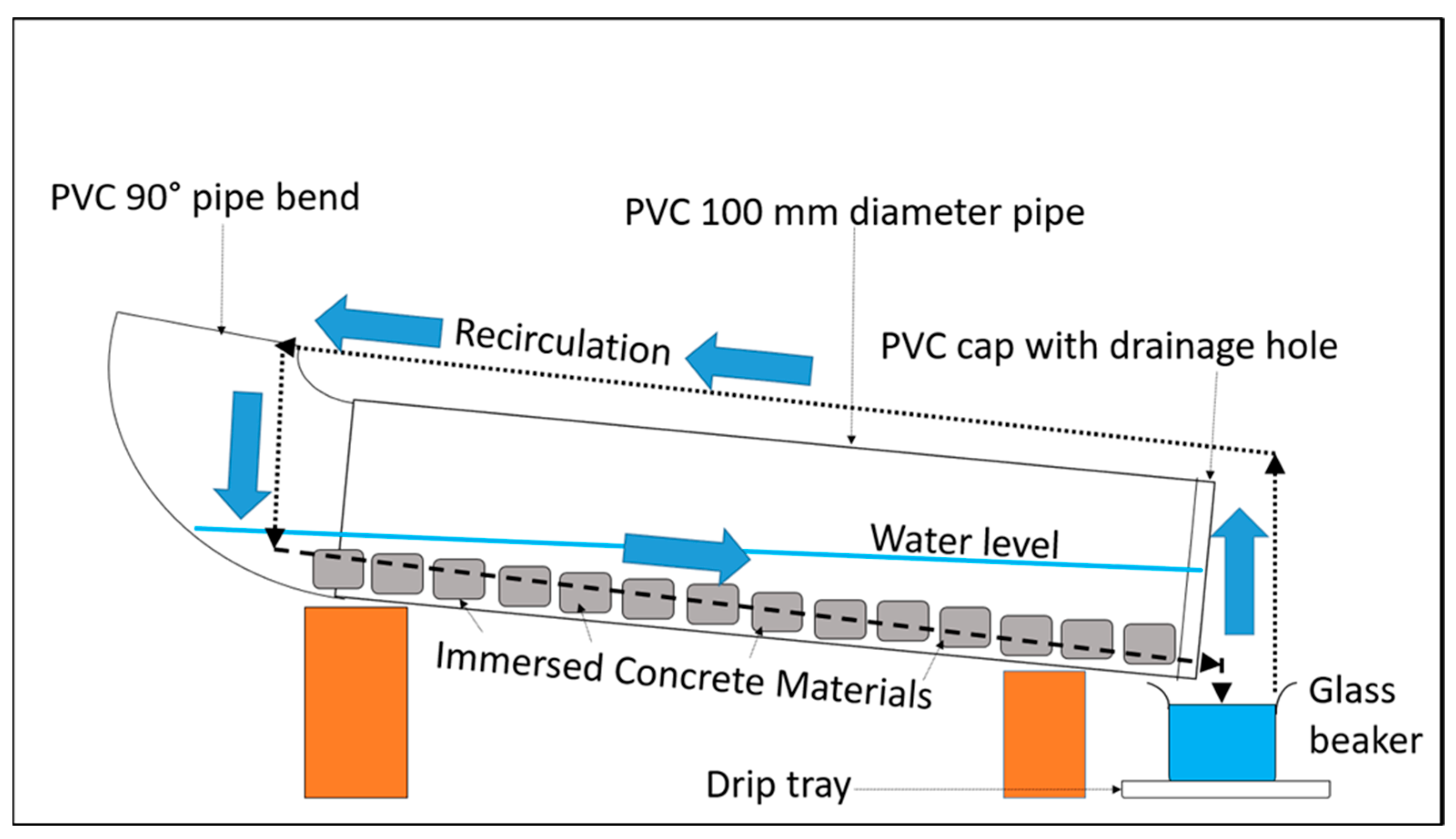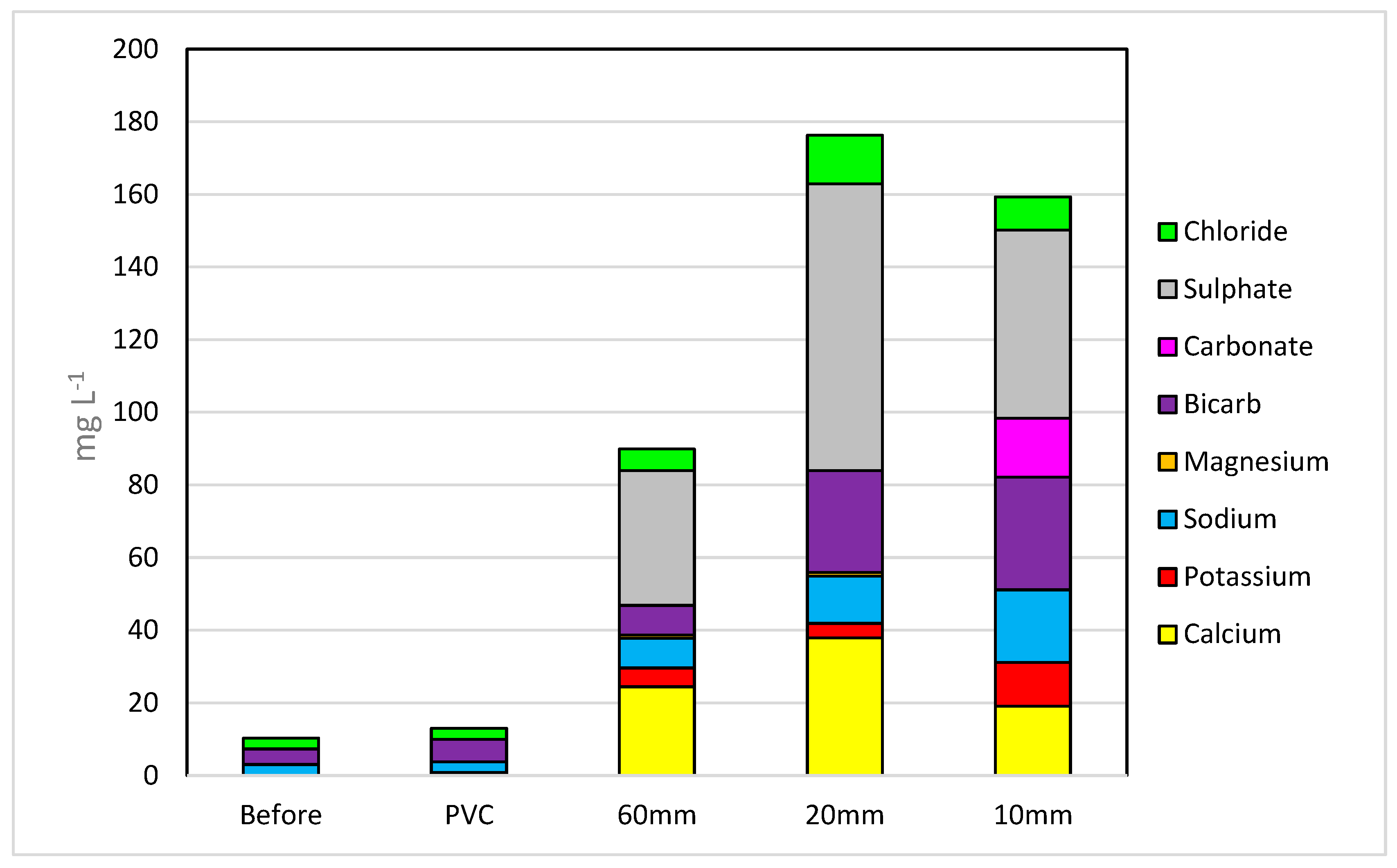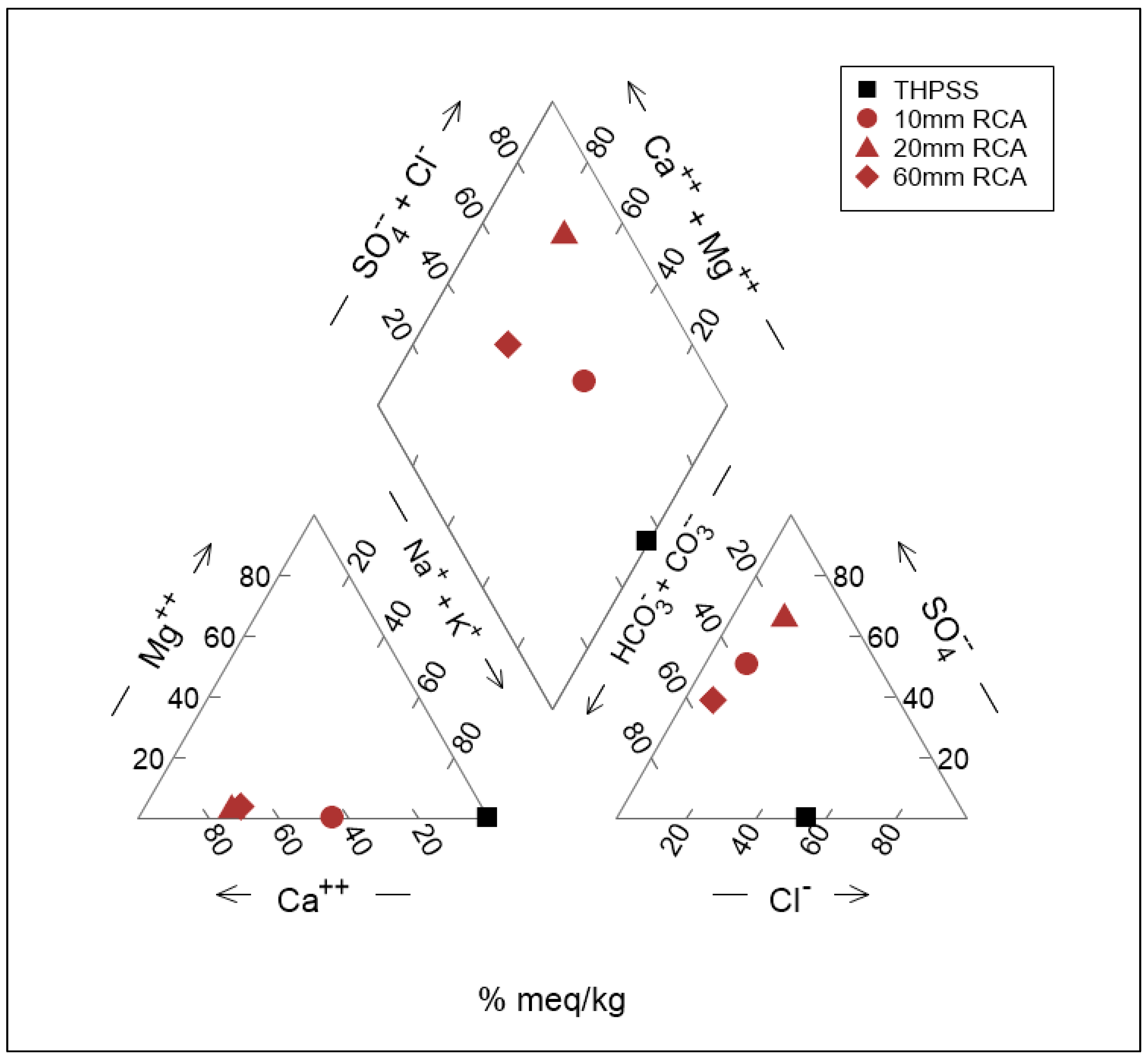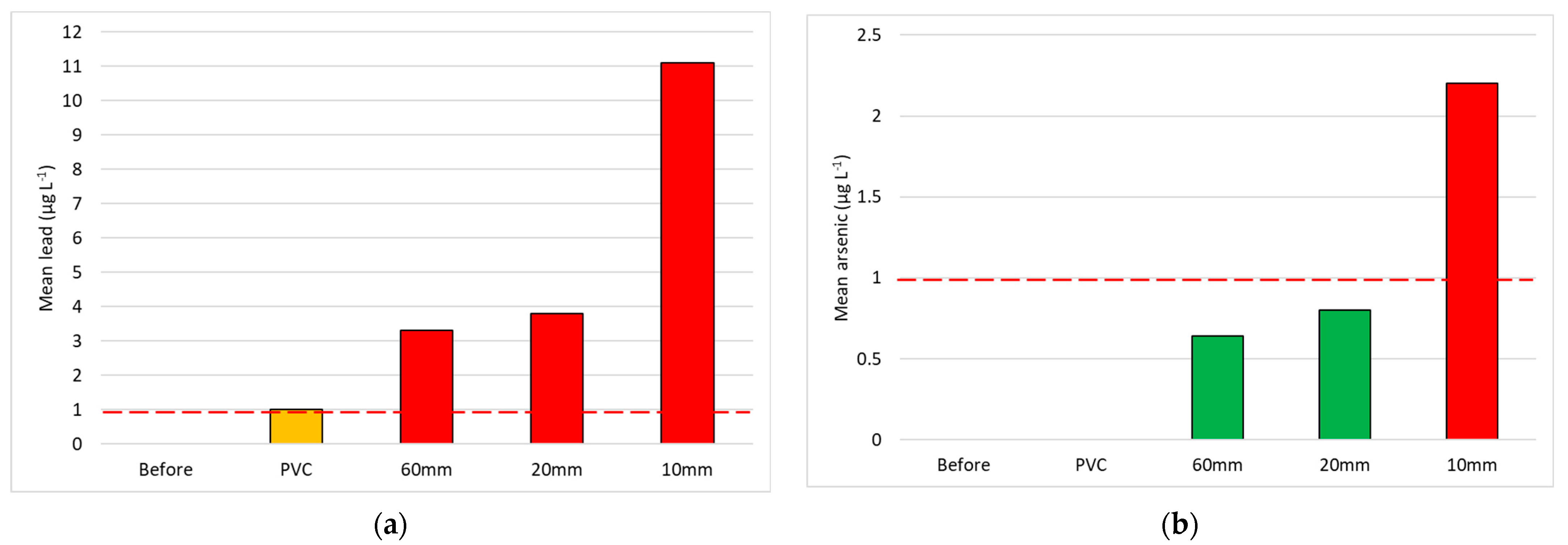Recirculating Water through Concrete Aggregates Rapidly Produced Ecologically Hazardous Water Quality
Abstract
:1. Introduction
2. Materials and Methods
2.1. Study Area
2.2. Collecting Water from the THPSS
2.3. Preparation of Aggregates
- RCA 10 mm (Turtle Nursery and Landscape Supplies, Rouse Hill, NSW);
- RCA 20 mm (Turtle Nursery and Landscape Supplies, Rouse Hill, NSW);
- RCA 60 mm (Raygal, Castlereagh, NSW).
2.4. Recirculation Experiment
2.5. Water Quality Guidelines for Ecosystem Protection
2.6. Data Analysis
Statistical Analysis
3. Results
3.1. Water Chemistry
3.1.1. Water pH and EC
3.1.2. Ionic Composition
3.1.3. Metals
4. Discussion
5. Conclusions
Author Contributions
Funding
Data Availability Statement
Acknowledgments
Conflicts of Interest
References
- Paul, M.J.; Meyer, J.L. Streams in the urban landscape. Ann. Rev. Ecol. Syst. 2001, 32, 333–365. [Google Scholar] [CrossRef]
- Kaushal, S.; Groffman, P.; Likens, G.; Belt, K.; Stack, W.; Kelly, V.; Band, L.; Fisher, G. Increased salinization of fresh water in the northeastern United States. Proc. Natl. Acad. Sci. USA 2005, 102, 13517–13520. [Google Scholar] [CrossRef] [PubMed]
- Tippler, C.; Wright, I.A.; Hanlon, A. Is catchment imperviousness a keystone factor degrading urban waterways? A case study from a partly urbanised catchment (Georges River, south-eastern Australia). Water Air Soil Pollut. 2012, 223, 5331–5344. [Google Scholar] [CrossRef]
- Walsh, C.J.; Roy, A.H.; Feminella, J.W.; Cottingham, P.D.; Groffman, P.M.; Morgan, R.P. The urban stream syndrome: Current knowledge and search for a cure. J. N. Am. Benthol. Soc. 2005, 24, 706–723. [Google Scholar] [CrossRef]
- Kaushal, S.S.; Likens, G.E.; Utz, R.M.; Pace, M.L.; Grese, M.; Yepsen, M. Increased River alkalinization in the eastern U.S. Environ. Sci. Technol. 2013, 47, 10302–10311. [Google Scholar] [CrossRef]
- Kaushal, S.S.; Duan, S.; Doody, T.R.; Haq, S.; Smith, R.M.; Newcomer Johnson, T.A.; Newcomb, K.D.; Gorman, J.; Bowman, N.; Mayer, P.M.; et al. Human-accelerated weathering increases salinization, major ions, and alkalinization in fresh water across land use. Appl. Geochem. 2017, 83, 121–135. [Google Scholar] [CrossRef] [PubMed]
- Australian Government. Department of Climate Change, Energy, the Environment and Water. Temperate Highland Peat Swamps on Sandstone. 2005. Available online: https://www.dcceew.gov.au/environment/biodiversity/threatened/assessments/temperate-highland-peat-swamps-2005 (accessed on 3 April 2023).
- International Union for Conservation of Nature. Greater Blue Mountains Area 2020 Conservation Outlook Assessment. Available online: https://worldheritageoutlook.iucn.org/explore-sites/wdpaid/220294 (accessed on 3 April 2023).
- Hensen, M.; Mahony, E. Reversing drivers of degradation in Blue Mountains and Newnes Plateau Shrub Swamp endangered ecological communities. Australas. Plant Conserv. J. Aust. Netw. Plant Conserv. 2010, 18, 5–6. [Google Scholar]
- Carroll, R.; Reynolds, J.K.; Wright, I.A. Geochemical signature of urbanization in Blue Mountains Upland Swamps. Sci. Total Environ. 2020, 699, 134393. [Google Scholar] [CrossRef] [PubMed]
- Mooney, S.; Martin, L. The unique and surprising environments of Temperate Highland Peat Swamps on Sandstone (THPSS) in the Blue Mountains, NSW. Australas. Plant Conserv. J. Aust. Netw. Plant Conserv. 2016, 24, 18–22. [Google Scholar]
- New South Wales National Parks and Wildlife Service. Greater Blue Mountains World Heritage Area Strategic Plan. Available online: https://www.environment.nsw.gov.au/-/media/OEH/Corporate-Site/Documents/Parks-reserves-and-protected-areas/Parks-plans-of-management/greater-blue-mountains-world-heritage-area-strategic-plan-080491.pdf (accessed on 3 April 2023).
- Belmer, N.; Tippler, C.; Wright, I.A. Aquatic ecosystem degradation of high conservation value upland swamps, Blue Mountains Australia. Water Air Soil Pollut. 2018, 229, 98. [Google Scholar] [CrossRef]
- Cowley, K.L.; Fryirs, K.A.; Hose, G.C. Identifying key sedimentary indicators of geomorphic structure and function of upland swamps in the Blue Mountains for use in condition assessment and monitoring. Catena 2016, 147, 564–577. [Google Scholar] [CrossRef]
- Belmer, N.; Wright, I.A.; Tippler, C. Urban geochemical contamination of high conservation value upland swamps, Blue Mountains, Australia. Water Air Soil Pollut. 2015, 226, 332–337. [Google Scholar] [CrossRef]
- Carroll, R.; Reynolds, J.K.; Wright, I.A. Signatures of Urbanization in Temperate Highland Peat Swamps on Sandstone (THPSS) of the Blue Mountains World Heritage Area. Water 2022, 14, 3724. [Google Scholar] [CrossRef]
- Chambers, L.G.; Chin, Y.P.; Filippelli, G.M.; Gardner, C.B.; Herndon, E.M.; Long, D.T.; Lyons, W.B.; Macpherson, G.L.; McElmurry, S.P.; McLean, C.E.; et al. Developing the scientific framework for urban geochemistry. Appl. Geochem. 2016, 67, 1–20. [Google Scholar] [CrossRef]
- Jacques, D.; Wang, L.; Martens, E.; Mallants, D. Modelling chemical degradation of concrete during leaching with rain and soil water types. Cem. Concr. Res. 2010, 40, 1306–1313. [Google Scholar] [CrossRef]
- Kaushal, S.S.; Wood, K.L.; Galella, J.G.; Gion, A.M.; Haq, S.; Goodling, P.J.; Haviland, K.A.; Reimer, J.E.; Morel, C.J.; Wessel, B.; et al. Making ‘chemical cocktails’—Evolution of urban geochemical processes across the periodic table of elements. Appl. Geochem. 2020, 119, 104632. [Google Scholar] [CrossRef] [PubMed]
- Bain, D.J.; Yesilonis, I.D.; Pouyat, R.V. Metal concentrations in urban riparian sediments along an urbanization gradient. Biogeochemistry 2012, 107, 67–79. [Google Scholar] [CrossRef]
- Grella, C.; Renshaw, A.; Wright, I.A. Invasive weeds in urban riparian zones: The influence of catchment imperviousness and soil chemistry across an urbanization gradient. Urban Ecosyst. 2018, 21, 505–517. [Google Scholar] [CrossRef]
- Davies, P.J.; Wright, I.A.; Jonasson, O.J.; Findlay, S.J. Impact of concrete and PVC pipes on urban water chemistry. Urban Water J. 2010, 7, 233–241. [Google Scholar] [CrossRef]
- Wright, I.A.; Davies, P.J.; Findlay, S.J.; Jonasson, O.J. A new type of water pollution: Concrete drainage infrastructure and geochemical contamination of urban waters. Mar. Freshw. Res. 2011, 62, 1355–1361. [Google Scholar] [CrossRef]
- Cooke, S.J.; Bergman, J.N.; Nyboer, E.A.; Reid, A.J.; Gallagher, A.J.; Hammerschlag, N.; Van de Riet, K.; Vermaire, J.C. Overcoming the concrete conquest of aquatic ecosystems. Biol. Conserv. 2020, 247, 108589. [Google Scholar] [CrossRef]
- Tippler, C.; Wright, I.A.; Davies, P.J.; Hanlon, A. The influence of concrete on the geochemical qualities of urban streams. Mar. Freshw. Res. 2014, 65, 1009–1017. [Google Scholar] [CrossRef]
- Rahman, M.A.; Imteaz, M.; Arulrajah, A.; Disfani, M.M. Suitability of recycled construction and demolition aggregates as alternative pipe backfilling materials. J. Clean. Prod. 2014, 66, 75–84. [Google Scholar] [CrossRef]
- McNeil, K.; Kang, T.H.K. Recycled Concrete Aggregates: A Review. Int. J. Concr. Struct. Mater. 2013, 7, 61–69. [Google Scholar] [CrossRef]
- Tang, Y.; Xiao, J.; Liu, Q.; Xia, B.; Singh, A.; Lv, Z.; Song, W. Natural gravel-recycled aggregate concrete applied in rural highway pavement: Material properties and life cycle assessment. J. Clean. Prod. 2022, 334, 130219. [Google Scholar] [CrossRef]
- Brulliard, C.; Cain, R.; Do, D.; Dornom, T.; Evans, K.; Lim, B.; Olesson, E.; Young, S. The Australian Recycling Sector. Department of Sustainability, Water, Population and Communities: Canberra, ACT, Australia, 2012. Available online: https://www.dcceew.gov.au/sites/default/files/documents/australian-recycling-sector.pdf (accessed on 3 April 2023).
- NSW EPA. Using Recycled Materials for Pavements, Earthworks and Drainage. NSW EPA Using Recycled Materials for Pavements, Earthworks and Drainage. 2021. Available online: https://www.epa.nsw.gov.au/your-environment/recycling-and-reuse/business-government-recycling/what-can-business-recycle/using-recycled-materials (accessed on 3 April 2023).
- Setunge, S.; Nguyen, N.; Alexander, B.L. Leaching of Alkali from Concrete in Contact with Waterways. Water Air Soil Pollut. Focus 2009, 9, 381–391. [Google Scholar] [CrossRef]
- Chen, J.; Bradshaw, S.; Benson, C.H.; Tinjum, J.M.; Edil, T.B. pH-dependent leaching of trace elements from recycled concrete aggregate. In Geocongress 2012; Hryciw, R.D., Athanasopoulos-Zekkos, A., Yesiller, N., Eds.; American Society of Civil Engineers: Oakland, CA, USA, 2012; pp. 3729–3738. [Google Scholar]
- Chen, J.; Tinjum, J.M.; Edil, T.B. Leaching of Alkaline Substances and Heavy Metals from Recycled Concrete Aggregate Used as Unbound Base Course. Transp. Res. Rec. 2013, 2349, 81–90. [Google Scholar] [CrossRef]
- Abbaspour, A.; Tanyu, B.F.; Cetin, B. Impact of aging on leaching characteristics of recycled concrete aggregate. Environ. Sci. Pollut. Res. 2016, 23, 20835–20852. [Google Scholar] [CrossRef]
- Bestgen, J.O.; Cetin, B.; Tanyu, B.F. Effects of extraction methods and factors on leaching of metals from recycled concrete aggregates. Environ. Sci. Pollut. Res. Int. 2016, 23, 12983–13002. [Google Scholar] [CrossRef]
- Purdy, K.; Reynolds, J.K.; Wright, I.A. Potential water pollution from recycled concrete aggregate material. Mar. Freshw. Res. 2020, 72, 58–65. [Google Scholar] [CrossRef]
- Wright, I.A.; Khoury, R.; Ryan, M.M.; Belmer, N.; Reynolds, J.K. Laboratory study of impacts of concrete fragment sizes on wetland water chemistry. Urban Water J. 2018, 15, 61–67. [Google Scholar] [CrossRef]
- APHA. Standard Methods for the Examination of Water and Wastewater, 21st ed.; American Public Health Association: Washington, DC, USA, 2006. [Google Scholar]
- ANZECC (Australian and New Zealand Environment and Conservation Council). Australian and New Zealand Guidelines for Fresh and Marine Waters; National Water Quality Management Strategy Paper No. 4; Australian and New Zealand Environment and Conservation Council: Canberra, ACT, Australia, 2001. Available online: https://www.waterquality.gov.au/anz-guidelines/resources/previous-guidelines/anzecc-armcanz-2000 (accessed on 3 April 2023).
- Christiansen, N.A.; Fryirs, K.A.; Green, T.J.; Hose, G.C. The impact of urbanization on community structure, gene abundance and transcription rates in microbes of upland swamps of Eastern Australia. PLoS ONE 2019, 14, e0213275. [Google Scholar] [CrossRef] [PubMed]
- Moore, J.; Bird, D.L.; Dobbis, S.K.; Woodward, G. Nonpoint source contributions drive elevated major ion and dissolved inorganic carbon concentrations in urban watersheds. Environ. Sci. Technol. Lett. 2017, 4, 198–204. [Google Scholar] [CrossRef]
- Connor, N.P.; Sarraino, S.; Frantz, D.E.; Bushaw-Newton, K.; Macavoy, S.E. Geochemical characteristics of an urban river: Influences of an urban landscape. Appl. Geochem. 2014, 47, 209–216. [Google Scholar] [CrossRef]
- Wu, H.; Duan, H.; Zheng, L.; Wang, J.; Niu, Y.; Zhang, G. Demolition waste generation and recycling potentials in a rapidly developing flagship megacity of South China: Prospective scenarios and implications. Constr. Build. Mater. 2016, 113, 1007–1016. [Google Scholar] [CrossRef]
- Ipeaiyeda, A.R.; Umo, N.S.; Okojevoh, G.E. Environmental pollution induced by an aluminum smelting plant in Nigeria. Glob. J. Sci. Front. 2012, 12, 2249–4626. [Google Scholar]
- United State Environmental Protection Agency (USEPA). National Recommended Water Quality Criteria-Correction: EPA 822/Z-99-001; United State Environmental Protection Agency: Washington, DC, USA, 1999.
- NHMRC. Australian Drinking Water Guidelines. Paper 6, 2011. National Water Quality Management Strategy. National Health and Medical Research Council, National Resource Management Ministerial Council, Commonwealth of Australia, Canberra. 2011. Available online: https://www.nhmrc.gov.au/about-us/publications/australian-drinking-water-guidelines (accessed on 3 April 2023).
- Levin, R.; Zilli Vieira, C.L.; Rosenbaum, M.H.; Bischoff, K.; Mordarski, D.C.; Brown, M.J. The urban lead (Pb) burden in humans, animals and the natural environment. Environ Res. 2021, 193, 110377. [Google Scholar] [CrossRef]
- Davis, B.; Birch, G. Comparison of heavy metal loads in stormwater runoff from major and minor urban roads using pollutant yield rating curves. Environ. Pollut. 2010, 158, 2541–2545. [Google Scholar] [CrossRef]
- Davis, A.P.; Shokouhian, M.; Ni, S. Loading estimates of lead, copper, cadmium, and zinc in urban runoff from specific sources. Chemosphere 2001, 44, 997–1009. [Google Scholar] [CrossRef]
- NSW Scientific Committee. Blue Mountains Swamps in the Sydney Basin Bioregion—Vulnerable Ecological Community Listing. 2007. Available online: https://www.environment.nsw.gov.au/topics/animals-and-plants/threatened-species/nsw-threatened-species-scientific-committee/determinations/final-determinations/2004-2007/blue-mountains-swamps-sydney-basin-bioregion-vulnerable-ecological-community-listing#:~:text=The%20Scientific%20Committee%2C%20established%20by,Schedule%202%20of%20the%20Act (accessed on 3 April 2023).
- American Coal Ash Association. Fly Ash Facts for Highway Engineers. 2003. Available online: https://www.fhwa.dot.gov/pavement/recycling/fafacts.pdf (accessed on 3 April 2023).
- Ash Development Association of Australia. Guide to the Use of Fly-Ash in Concrete in Australia. Fly Ash Data Reference Sheet Number 1. 2009 P.O. Box 1194 Wollongong NSW 2500 Australia. Available online: http://www.adaa.asn.au/uploads/default/files/adaa-ref_data_sheet_1.pdf (accessed on 3 April 2023).
- Oner, A.; Akyuz, S.; Yildiz, R. An experimental study on strength development of concrete containing fly ash and optimum usage of fly ash in concrete. Cem. Concr. Res. 2005, 35, 1165–1171. [Google Scholar] [CrossRef]
- Rahman, M.A.; Imteaz, M.A.; Arulrajah, A.; Piratheepan, J.; Disfani, M.M. Recycled construction and demolition materials in permeable pavement systems: Geotechnical and hydraulic characteristics. J. Clean. Prod. 2015, 90, 183–194. [Google Scholar] [CrossRef]








| Indicator | THPSS Guidelines |
|---|---|
| EC | <55 µS cm−1 |
| pH | <5.8 pH units [15,16] |
| Aluminium | <27 µg L−1 (if pH > 6.5) |
| Arsenic | <1.0 µg L−1 |
| Lead | <1.0 µg L−1 |
| Nickel | <8.0 µg L−1 |
| Zinc | <2.4 µg L−1 |
| After 60 min Recirculation | |||||
|---|---|---|---|---|---|
| Variable (Unit) | THPSS (Before) | PVC (Control) | 10 mm RCA | 20 mm RCA | 60 mm RCA |
| pH (pH units) | 5.71–5.78 (5.76) | 6.5–6.69 (6.62) ** | 9.82–10.1 (9.96) *** | 8.58–8.68 (8.63) *** | 8.82–8.85 (8.83) *** |
| EC (µS cm−1) | 17.52–17.77 (17.64) | 20.31–20.92 (20.65) ** | 250.5–274 (263.6) *** | 302–316 (308) *** | 186–191.6 (184.1) *** |
| Temperature (°C) | 17.1–17.5 (17.3) | 19–19.1 (19.08) *** | 19.8–20.0 (19.9) *** | 19.5–19.8 (19.7) | 19.2–19.6 (19.4) *** |
| Calcium (mg L−1) | ND | 0.7–0.8 (0.77) *** | 16–21 (19) *** | 35–40 (37.8) *** | 24–25 (24.4) *** |
| Potassium (mg L−1) | ND | ND | 12–12 (12) *** | 4–4 (4) *** | 5.1–5.4 (5.2) *** |
| Sodium (mg L−1) | 3 | 3 NS | 18–21 (20) *** | 12–14 (13) *** | 8–8.6 (8.2) *** |
| Magnesium (mg L−1) | ND | ND | ND | 1–1 (1) *** | 0.8–0.9 (0.84) *** |
| Hardness (mg L−1) | ND | ND | 41–53 (47.9) *** | 93–110 (99.6) *** | 62–66 (64.3) *** |
| Bicarbonate (mg L−1) | ND–6 (4.3) | 5–7 (6.16) * | 26–49 (31) *** | 26–30 (28) *** | 37–39 (38.2) *** |
| Carbonate (mg L−1) | ND | ND | 13–21 (13.0) ** | ND | ND |
| Total Alk. (mg L−1) | ND–6 (4.3) | 5–7 (6.16) * | 39–68 (47) *** | 26–30 (28) *** | 37–39 (38.2) *** |
| Sulphate (mg L−1) | ND | ND | 44–58 (51.7) *** | 77–81 (79) *** | 36–38 (37.1) *** |
| Chloride (mg L−1) | 3 | 3 NS | 8–10 (9.1) *** | 13–14 (13.4) *** | 5–7 (5.9) *** |
| Arsenic (µg L−1) | ND | ND | 2–3 (2.2) *** | ND–1 (0.8) ** | ND–1 (0.64) NS |
| Aluminium (µg L−1) | 100–130 (115) | 90–110 (100) * | 1500–3700 (2367) *** | 290–450 (380) *** | 970–2200 (1404) *** |
| Barium (µg L−1) | 2–3 (2.5) | 2–3 (2.5) NS | 18–49 (31.9) ** | 9–12 (10.7) ** | 12–17 (13.9) *** |
| Chromium (µg L−1) | ND | ND | 23–30 (27) *** | 5–6 (5.8) *** | 6–16 (11.4) *** |
| Lead (µg L−1) | ND | ND–1.0 (0.75) ** | 6–18 (11.1) *** | 3–4 (3.8) *** | 3–4 (3.3) *** |
| Lithium (µg L−1) | ND | ND | 24–27 (25.6) *** | 3–4 (3.3) *** | 11–13 (12) *** |
| Manganese (µg L−1) | ND | ND–6.0 (3.5) * | 30–85 (55.8) *** | 10–14 (11.9) *** | 28–44 (34.8) *** |
| Molybdenum (µg L−1) | ND | ND | 6–9 (7.1) *** | 3–4 (3.6) *** | 3–9 (6.1) *** |
| Selenium (µg L−1) | ND | ND | ND | ND | ND |
| Strontium (µg L−1) | ND–1.9 (1.5) | 1.1–2.0 (0.95) NS | 78–100 (89.9) *** | 150–170 (160) *** | 40–48 (44.7) *** |
| Titanium (µg L−1) | ND–1.5 (0.9) | ND–1.0 (0.95) NS | 43–230 (106.7) *** | 7.7–11 (9.4) *** | 25–76 (47.9) *** |
| Vanadium (µg L−1) | ND | ND | 20–32 (24.6) *** | 3–4 (3.6) *** | 4–7 (5.3) *** |
| Zinc (µg L−1) | 1–11 (4.25) | 4–10 (7.33) * | 13–29 (20.8) ** | 10–17 (13.1) ** | 10–16 (12.9) ** |
| Uranium (µg L−1) | ND | ND | ND | ND | ND |
| Ionic Strength (µmol L−1) | 116 | 266 | 3211 | 4024 | 2788 |
| Ca(OH)2 SI | −17.9 | −14.1 | −6.2 | −8.5 | −8.3 |
| Calcite SI | −7.7 | −4.0 | 1.3 | 0.3 | 0.7 |
Disclaimer/Publisher’s Note: The statements, opinions and data contained in all publications are solely those of the individual author(s) and contributor(s) and not of MDPI and/or the editor(s). MDPI and/or the editor(s) disclaim responsibility for any injury to people or property resulting from any ideas, methods, instructions or products referred to in the content. |
© 2023 by the authors. Licensee MDPI, Basel, Switzerland. This article is an open access article distributed under the terms and conditions of the Creative Commons Attribution (CC BY) license (https://creativecommons.org/licenses/by/4.0/).
Share and Cite
Wright, I.A.; Nettle, H.; Franklin, M.J.M.; Reynolds, J.K. Recirculating Water through Concrete Aggregates Rapidly Produced Ecologically Hazardous Water Quality. Water 2023, 15, 1705. https://doi.org/10.3390/w15091705
Wright IA, Nettle H, Franklin MJM, Reynolds JK. Recirculating Water through Concrete Aggregates Rapidly Produced Ecologically Hazardous Water Quality. Water. 2023; 15(9):1705. https://doi.org/10.3390/w15091705
Chicago/Turabian StyleWright, Ian A., Holly Nettle, Michael J. M. Franklin, and Jason K. Reynolds. 2023. "Recirculating Water through Concrete Aggregates Rapidly Produced Ecologically Hazardous Water Quality" Water 15, no. 9: 1705. https://doi.org/10.3390/w15091705





